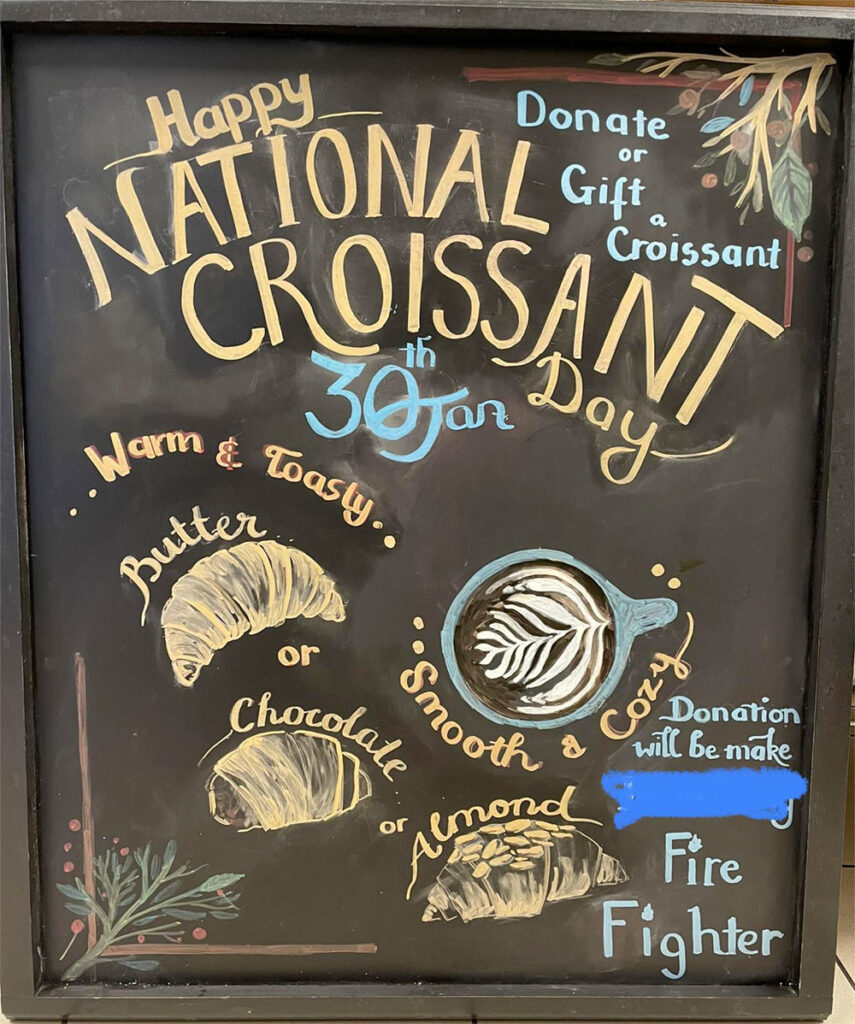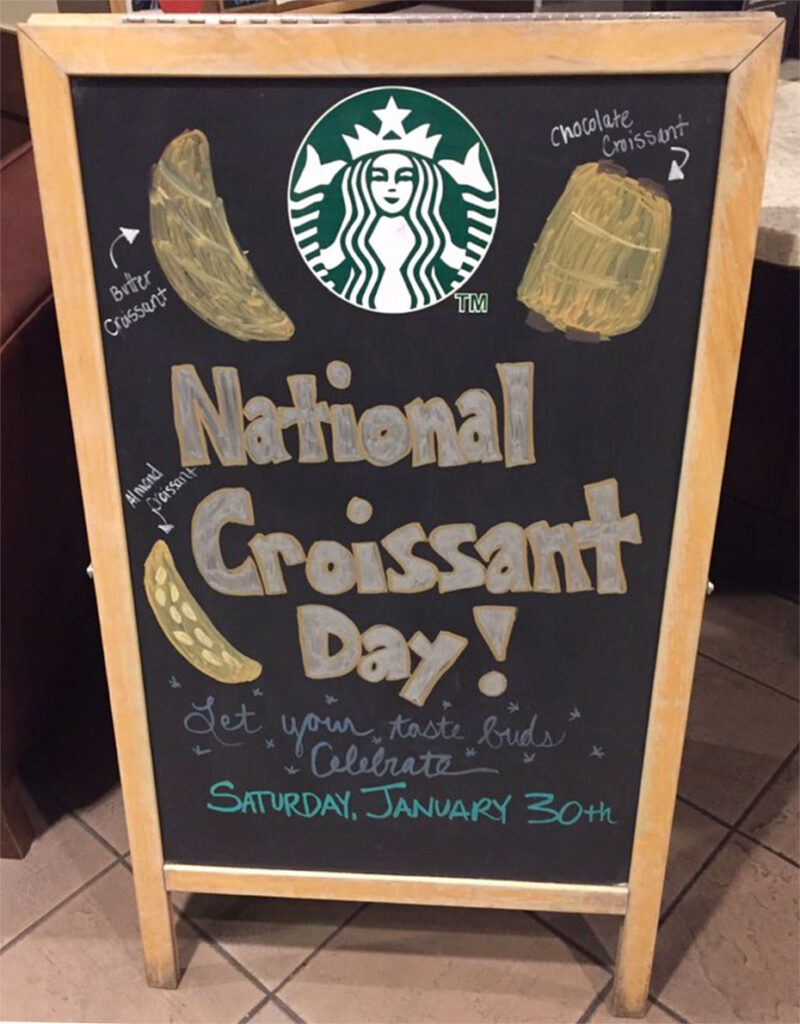National Croissant Day, celebrated on January 30th each year, is a day dedicated to appreciating the flaky, buttery goodness that is the croissant. This delectable pastry, known for its crescent shape, has become a staple in bakeries and breakfast tables around the world, embodying the artistry and tradition of French baking. However, the croissant’s journey to becoming a symbol of French culinary excellence is as layered as the pastry itself, involving cross-cultural influences, historical milestones, and evolving tastes.
Croissant Origins | Croissant Day History | Where to Celebrate | What’s the Point?
Marie Antoinette + the Inspiration for a Croissant Day:

Before we dive into the celebration of National Croissant Day, let’s unfold the layers of history behind the croissant. Contrary to popular belief, the origins of the croissant are not rooted in France but in Austria, where it was known as the “kipferl.” The kipferl, a plain, crescent-shaped pastry, dates back to the 13th century, with its shape reportedly inspired by the Islamic crescent seen on the battle standards of the Ottoman Empire during their sieges of Vienna.
The transformation from kipferl to croissant is often attributed to the siege of Vienna in 1683. According to popular lore, Viennese bakers, working in the early hours, heard the Turks tunneling under the city walls and raised the alarm, contributing to the city’s defense. In celebration, they baked bread in the shape of the Ottoman crescent. The story, while engaging, is more myth than history.
However, what is clear is that the croissant’s journey to France began with Marie Antoinette. The Austrian princess introduced the court to her homeland’s pastries, including the kipferl, which French bakers eventually transformed into the butter-laden, flaky croissant we know today.
Let them eat croissants! Marie Antoinette, the last Queen of France before the French Revolution, was known for her lavish lifestyle and, unfortunately, her disconnect from the common people. Rumor has it she said “Let them eat cake” when told the peasants had no bread. Married to Louis XVI at just 14, her story ended tragically on the guillotine.
The croissant became entrenched in French culture by the early 20th century, with its preparation refined to an art form. The classic French croissant is made with a yeast-leavened dough and a technique known as laminating, where the dough is repeatedly folded and rolled out with butter. This meticulous process results in the croissant’s signature layers and airy texture, making it a showcase of a baker’s skill and patience.
While the Germans celebrate Currywurst, the French decided to dedicate an entire day to celebrate the croissant!
Croissant Day History:
The origins of National Croissant Day date back to its first observance on January 30th, 2006. Since then, the day has gained popularity, especially in the United States, as a way to celebrate the culinary delight that the croissant represents. National Croissant Day serves as an opportunity to explore the variety and versatility of croissants, from the traditional plain croissant to modern fillings and variations like almond, chocolate, hazelnut, and ham and cheese.
Today, bakeries and cafes across the globe celebrate National Croissant Day with special offers, new variations of the pastry, and events that educate customers about the history and art of croissant making. Social media plays a significant role in spreading awareness of the day, with #NationalCroissantDay showcasing the creativity and passion of both professional and home bakers.
The celebration of National Croissant Day also reflects the growing interest in artisanal and authentic food experiences. Consumers are increasingly seeking out high-quality, handcrafted products that tell a story or connect them to a tradition. The croissant, with its rich history and complex preparation, fits perfectly into this trend, offering not just a delicious bite but a link to French culinary heritage.
How to Celebrate National Croissant Day:

So, you want to show your croissant patriotism on October 30th? Here are 5 ideas for how you can observe and celebrate National Croissant Day this year:
- Bakery Hop: Visit a local bakery or two to sample their finest croissants including Croissant Day specials.
- DIY Croissants: Feeling crafty? Try your hand at making croissants from scratch at home. Yes, it’s a bit of a challenge, but imagine the bragging rights (and the delicious rewards).
- Croissant Potluck: Gather friends or coworkers and have everyone bring a different type of croissant. Sweet, savory, or downright experimental – it’s a croissant party!
- Social Media Bake-off: Show off your baking skills or your favorite croissant finds on social media. A little #NationalCroissantDay hashtag could even make you a trendsetter.
- Support Local: Make it a point to buy your croissants from a local bakery. It’s a great way to show some love to the artisans in your community while enjoying some flaky goodness. They might even donate part of the Croissant Day profits to a local charity or organization.
Tip: Don’t forget to share photos of your adventures on social media with #NationalCroissantDay!
Starbucks + Who Else Celebrates National Croissant Day?

Looking to get your croissant on? Here are popular restaurants to celebrate National Croissant Day:
- Starbucks: The coffee giant often marks the day with special offers on their buttery croissants. It’s a perfect excuse for that coffee and croissant break.
- Panera Bread: Known for their bakery items, Panera Bread typically celebrates with a nod to their assortment of croissants, inviting customers to indulge.
- Au Bon Pain: This café bakery makes National Croissant Day a real treat, showcasing their variety from almond to chocolate croissants.
- Local French Bakeries: Many local French bakeries join in the celebration, offering freshly baked, authentic croissants. It’s like a mini trip to Paris!
- Whole Foods Market: They often feature a selection of croissants in their bakery section, making it easy to celebrate with organic and artisan options.
- Burger King offers free or discounted Croissan’wiches on National Croissant Day. (The French would probably not approve!)
Tip: Besides featuring croissants on the menu, these chain bakeries may also offer croissant deals and promotions!
The Significance of National Croissant Day

So, what’s the point in dedicating an entire day on the calendar to croissants? Beyond indulging in a delicious pastry, National Croissant Day highlights the importance of cultural exchange and adaptation in culinary traditions. The croissant, with its roots in Austrian baking, adapted and perfected by French artisans, exemplifies how food can transcend borders, embodying the blending of cultures.
National Croissant Day also shines a spotlight on the art of baking, reminding us of the time, skill, and dedication involved in creating pastries that seem simple but are complex in their preparation. Bakers and pastry chefs take this opportunity to showcase their craft, experimenting with new flavors and techniques to push the boundaries of what a croissant can be.
In a broader sense, National Croissant Day encourages us to appreciate the small pleasures in life. A well-made croissant, with its golden crust and tender layers, can be a moment of joy in the midst of a busy day, a reminder of the beauty in simplicity and the joy of savoring the moment.
Idea: I believe that National Croissant Day is really about being present in the moment and honoring a special food that really takes a lot of time, effort, and care to make If you think about it, it’s kind of the opposite of how McDonald’s burgers are made!
Conclusion
National Croissant Day is a testament to the enduring appeal of the croissant, a pastry that has traveled from the Ottoman sieges of Vienna to the heart of French cuisine and beyond. It’s a day to celebrate the richness of culinary traditions, the art of baking, and the simple pleasures that thoughtfully prepared food can bring into our lives.
Whether enjoyed plain with a cup of coffee or filled with sweet or savory delights, the croissant remains a symbol of craftsmanship, culture, and the joy of sharing on multiple layers.
I hope you enjoyed our history of National Croissant Day. Thanks for visiting Pretty Sweet!

